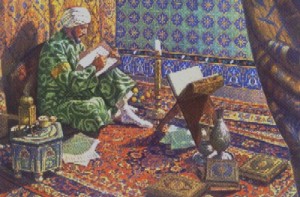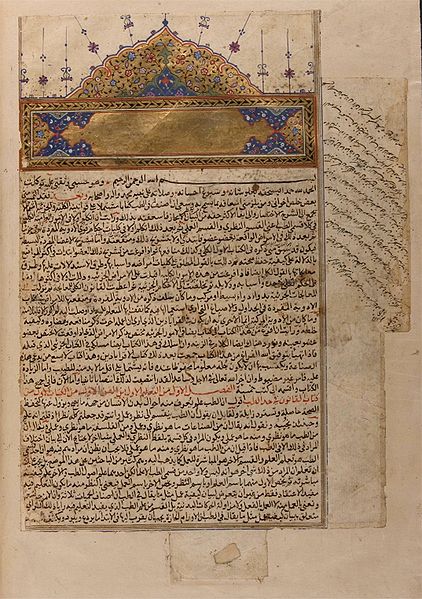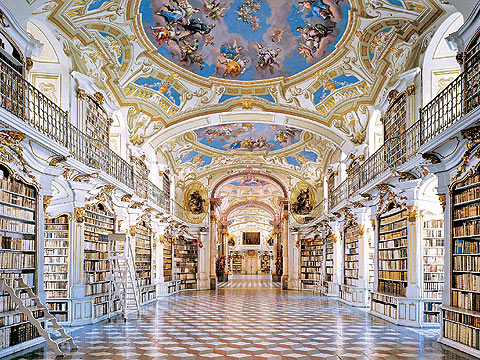AVICENNA, UNANI MEDICINE & MATERIA MEDICA

Systematische Übersicht der Materia medica homeopathica
Stiftsbibliothek Admont/Monastery Library
( Herbal garden, handwritten Materia Medica, Monastery Guide etc.)
Abū ‘AlÄ� al-Ḥusayn ibn ‘Abd AllÄ�h ibn SÄ�nÄ�‘, known as Abū AlÄ� SÄ�nÄ�(Persian: ابوعلی سینا) or, more commonly, Ibn SÄ�nÄ�(Arabic: ابن سینا), but most commonly known in English by his Latinized name Avicenna (Greek: Aβιτζιανός, Avitzianós), (c. 980 – 1037) was a polymath of Persian origin and the foremost physician and philosopher of his time. He was also an astronomer, chemist, geologist, Hafiz, Islamic psychologist, Islamic scholar, Islamic theologian, logician, paleontologist, mathematician, Maktab teacher, physicist, poet, and scientist.
Ibn S�n� studied medicine under a physician named Koushyar. He wrote almost 450 treatises on a wide range of subjects, of which around 240 have survived. In particular, 150 of his surviving treatises concentrate on philosophy and 40 of them concentrate on medicine.His most famous works are The Book of Healing, a vast philosophical and scientific encyclopaedia, and The Canon of Medicine, which was a standard medical text at many medieval universities. Read More: > HERE <
Materia medica is a Latin medical term for the body of collected knowledge about the therapeutic properties of any substance used for healing (i.e., medicines). In Latin, the term literally means „medical material/substance“. The term was used from the period of the Roman Empire until the twentieth century, but has now been generally replaced in medical education contexts by the term pharmacology. Read More: > HERE <
Ibnsina Academy of Medieval Medicine and Sciences – Abu Ali Ibn Sina is a well-known personality among the physicians of Unani medicine and scientists of physical sciences since medieval times. To commemorate and to institutionalize an academy named after him, Ibn Sina Academy of Medieval Medicine & Sciences, was founded on March 1, 2000. The Academy has been registered under Indian Trusts Act, 1882 on August 14, 2000. Mr. M. Hamid Ansari, Vice-chancellor of Aligarh Muslim University, Aligarh formally inaugurated it, on April 20, 2001. Department of AYUSH, Ministry of Health & Family Welfare, Govt. of India gave accreditation to the academy in 2004. The Academy is now a non-governmental, non-political and non-profit organization with multiple aims and objectives.
Abu Ali al-Hussain Ibn Abdallah Ibn Sina was born in 980 A.D. at Afshaneh near Bukhara. The young Bu Ali received his early education in Bukhara, and by the age of ten had become well versed in the study of the Qur’an and various sciences. He started studying philosophy by reading various Greek, Muslim and other books on this subject and learnt logic and some other subjects from Abu Abdallah Natili, a famous philosopher of the time. While still young, he attained such a degree of expertise in medicine that his renown spread far and wide. At the age of 17, he was fortunate in curing Nooh Ibn Mansoor, the King of Bukhhara, of an illness in which all the well-known physicians had given up hope. On his recovery, the King wished to reward him, but the young physician only desired permission to use his uniquely stocked library.
He was the most famous physician, philosopher, encyclopaedist, mathematician and astronomer of his time. His major contribution to medical science was his famous book al-Qanun, known as the „Canon“ in the West. The Qanun fi al-Tibb is an immense encyclopaedia of medicine extending over a million words. It surveyed the entire medical knowledge available from ancient and Muslim sources. Due to its systematic approach, „formal perfection as well as its intrinsic value, the Qanun superseded Razi’s Hawi, Ali Ibn Abbas’s Maliki, and even the works of Galen, and remained supreme for six centuries“. In addition to bringing together the then available knowledge, the book is rich with the author’s original eontribution. His important original contribution includes such advances as recognition of the contagious nature of phthisis and tuberculosis; distribution of diseases by water and soil, and interaction between psychology and health.
In addition to describing pharmacological methods, the book described 760 drugs and became the most authentic materia medica of the era. He was also the first to describe meningitis and made rich contributions to anatomy, gynaecology and child health.
Avicenna wrote 99 books, almost all in Arabic, the language of religious and scientific expression in the entire Muslim world at that time. However, two of his works, the `Daneshnameh-e-Alai‘ (Encylopedia of philosophical sciences) and a small treatise on the pulse, were written in Farsi, his native language. He wrote about natural philosophy and astronomy, theology and metaphysics, medicine, psychology, music, mathematics and physical sciences and he is also the reported author of Persian quatrains and short poems:
„Up from Earth’s Centre through the Seventh Gate I rose, and on the Throne of Saturn sate, And many a knot unravelled by the Road, But not the Master-knot of Human Fate.“
His philosophical encyclopaedia Kitab al-Shifa was a monumental work, embodying a vast field of knowledge from philosophy to science. He classified the entire field as follows: theoretical knowledge: physics, mathematics and metaphysics; and practical knowledge: ethics, economics and politics. His philosophy synthesises Aristotelian tradition, Neoplatonic influences and Muslim theology.
Ibn Sina also contributed to mathematics, physics, music and other fields. He explained the „casting out of nines“ and its application to the verification of squares and cubes. He made several astronomical observations, and devised a contrivance similar to the vernier, to increase the precision of instrumental readings. In physics, his contribution comprised the study of different forms of energy, heat, light and mechanical, and such concepts as force, vacuum and infinity. He made the important observation that if the perception of light is due to the emission of some sort of particles by the luminous source, the speed of light must be finite. He propounded an interconnection between time and motion, and also made investigations on specific gravity and used an air thermometer.
In the field of music, his contribution was an improvement over Farabi’s work and was far ahead of knowledge prevailing else- where on the subject. Doubling with the fourth and fifth was a ‚great‘ step towards the harmonic system and doubling with the third seems to have also been allowed. Ibn Sina observed that in the series of consonances represented by (n + 1)/n, the ear is unable to distinguish them when n = 45. In the field of chemistry, he did not believe in the possibility of chemical transmutation because, in his opinion, the metals differed in a fundamental sense. These views were radically opposed to those prevailing at the time. His treatise on minerals was one of the „main“ sources of geology of the Christian encyclopaedists of the thirteenth century. Besides Shifa his well-known treatises in philosophy are al-Najat and Isharat.
- Articles on Materica Medica:
- ISLAMIC PLANT MEDICINE AND HISTORY <
- UNANI MEDICINE <
- Jews, Christs & Muslims ~ Intercultural Dialog <
- Indian medicines – ayurveda, siddha and unani <
- �yurvedische Materia medica, Nighantu <
- Western Herbs from the TCM Perspective <
- Meet AVICENNA, studies, friends, fans at fb <
- Meet Islamic Medicine „The Cure for Every Disease“, studies, friends at fb <
- Meet KARKHANA ZINDA TILISMATH, Unani Medicine, friends, studies at fb <
- Council for a Parliament of the World’s Religions (CPWR) <

Avicenna canon 1597 – The opening decoration and invocation to Allah from a 16th century manuscript of Avicenna’s Canon (Yale, Medical Historical Library, Cushing Arabic ms. 5, copied in 1006 H./1597-98 A.D.
http://www.library.yale.edu/oacis/scopa/scopa_ibnsina_ms5.html

Abbey Admont Library /Stift Admont Bibliothek
Admont Abbey (Stift Admont) is a foundation of the Benedictines on the River Enns in the town of Admont in Austria and is the oldest remaining monastery in Styria. It contains the largest monastic library in the world and a long-established scientific collection, and is known for its Baroque architecture and collections of art and manuscripts.
The abbey’s location on the borders of the Gesäuse National Park is of unusual scenic beauty. Read More: > HERE <
Comments are closed.